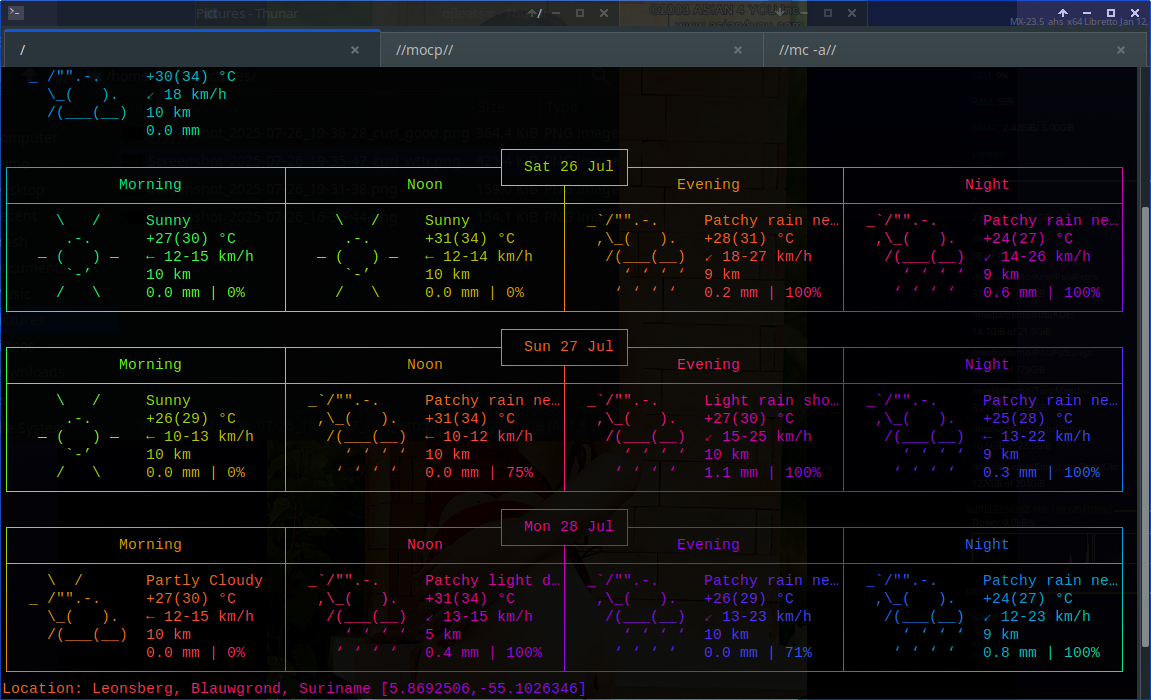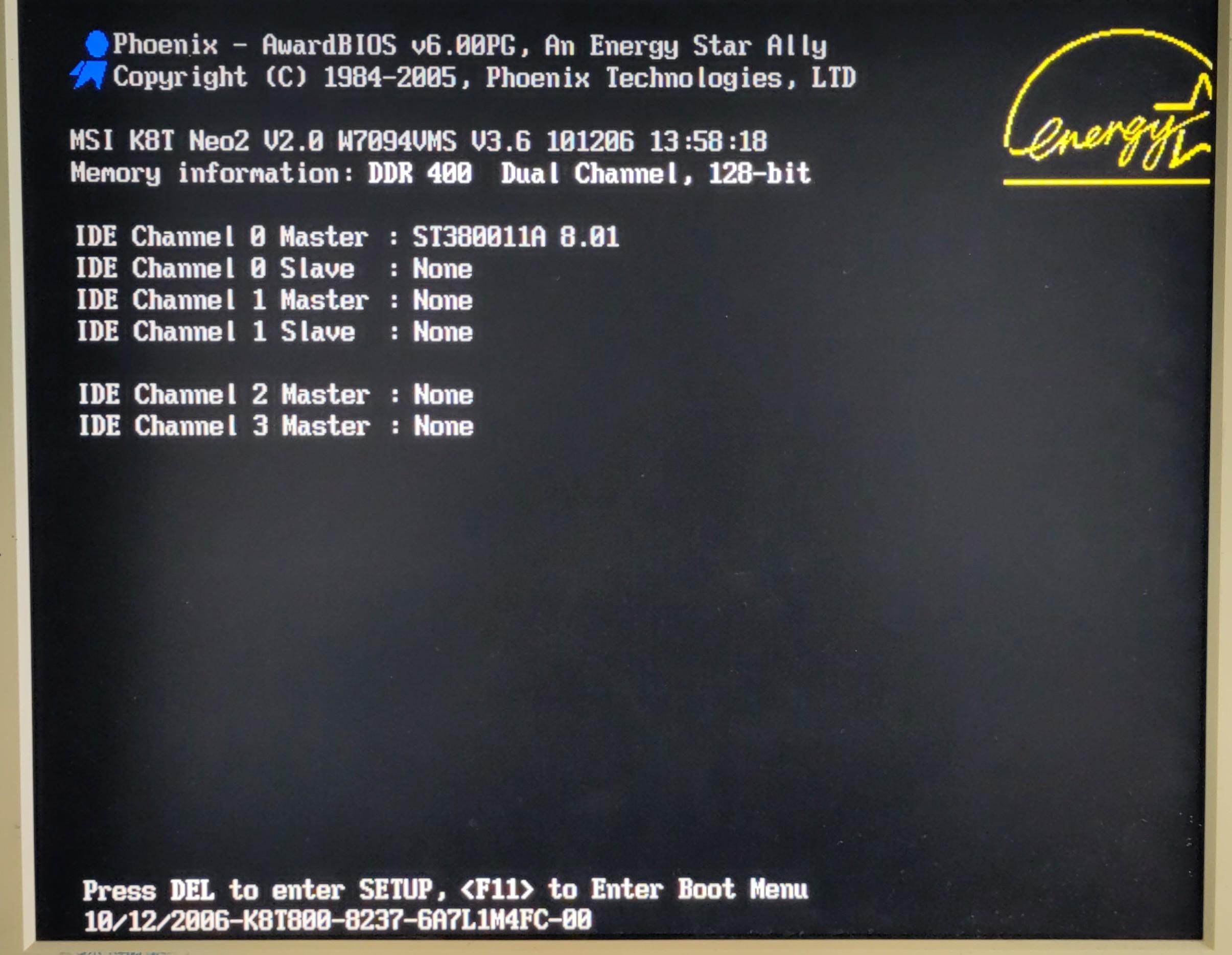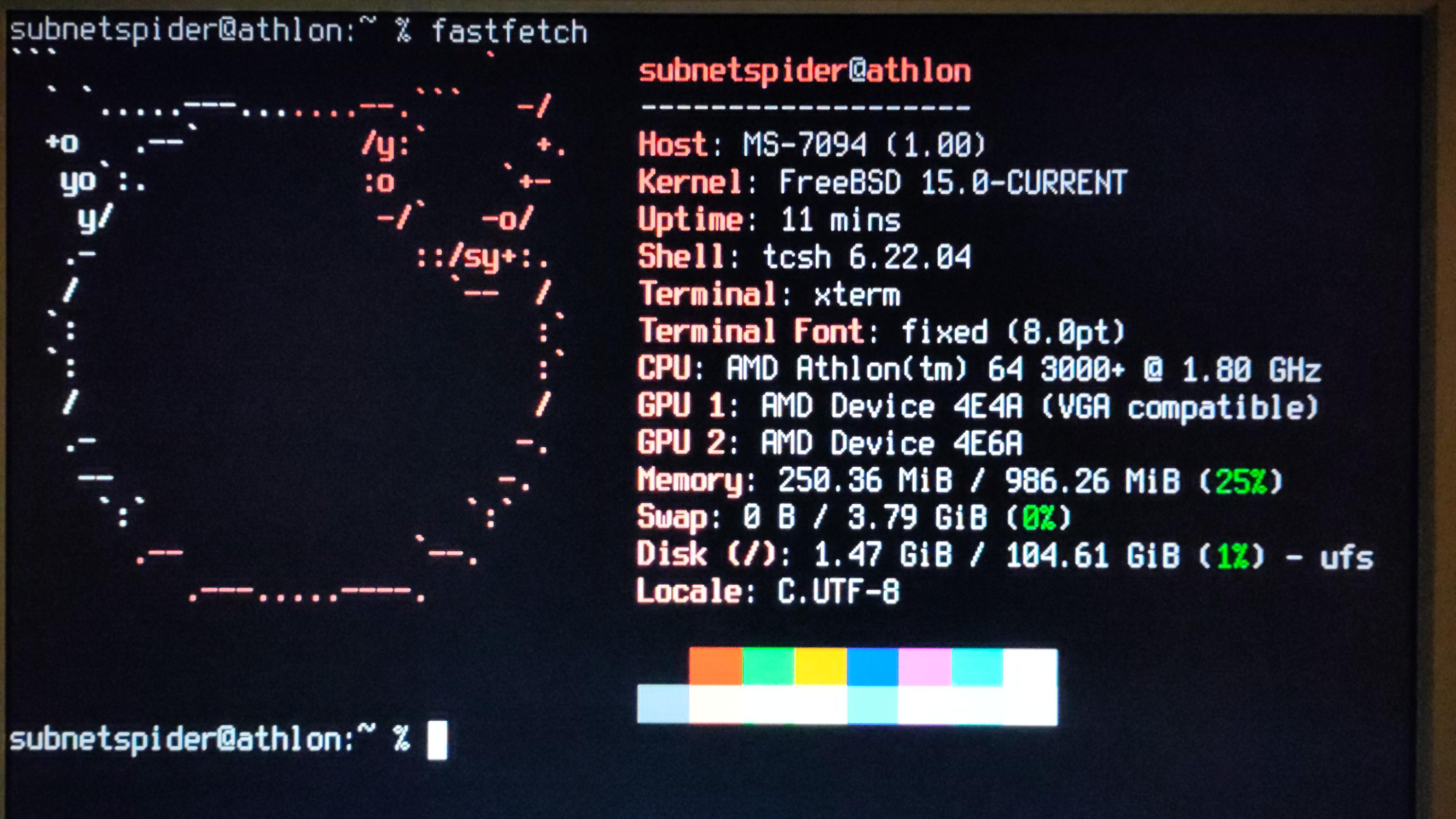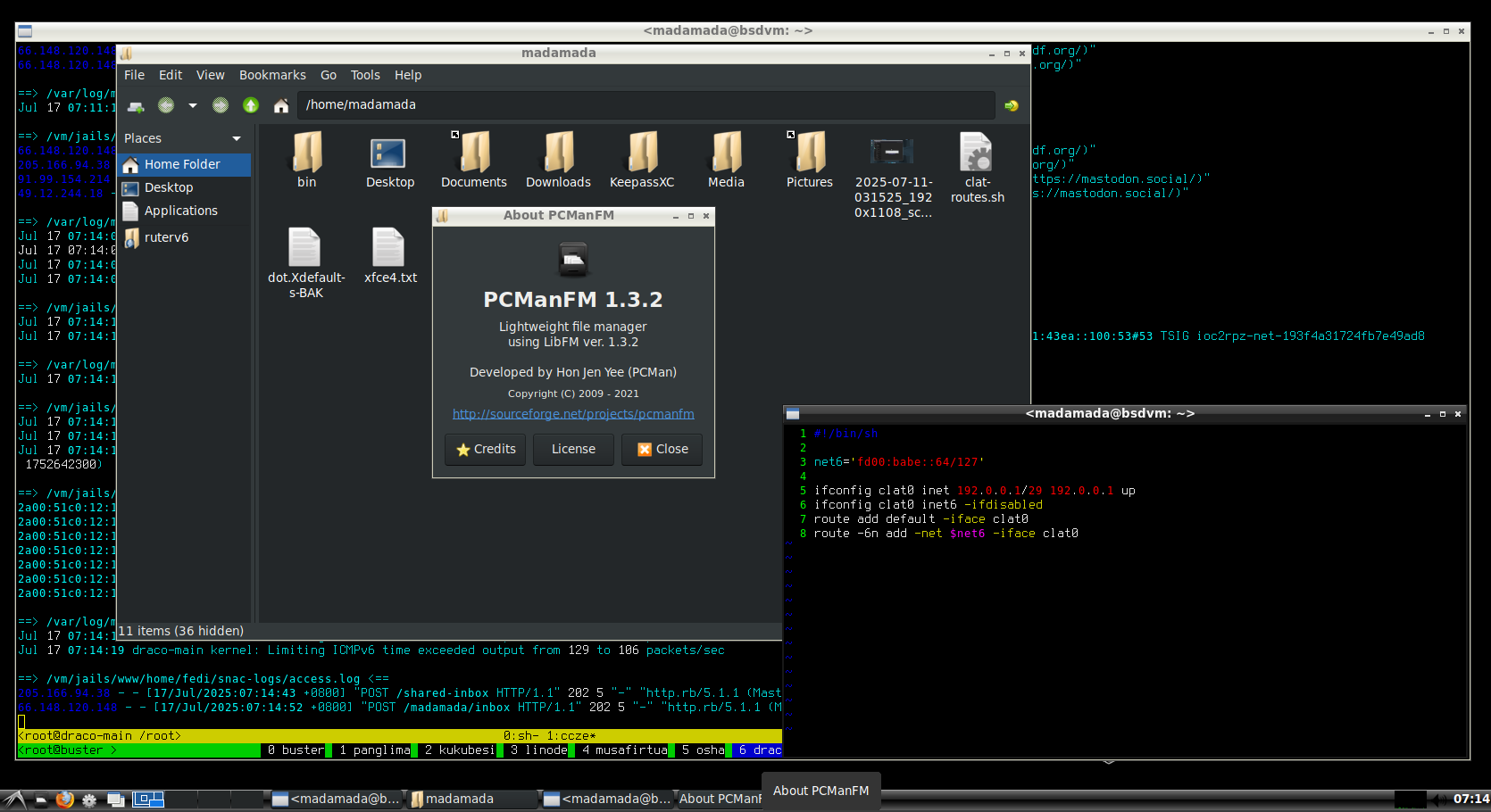I love the power of curl combined with wttr.in
Giving this example for those of us who love to use true free services for our work / live flow
I've been using wttr for decade(s)
Read here for more examples.
https://github.com/chubin/wttr.in?tab=readme-ov-file
#wttr #weather #curl #opensource #free #POSIX #API #programming #bash #csh #ksh #sh #portable #freeBSD #BSD #Linux
...
I had to trim of this part from the ALT text due to max field size
For Sunday, July 27, the morning is sunny with a temperature of +26°C and a wind speed of 10 km/h, followed by patchy rain at noon with a temperature of +31°C and a wind speed of 10 km/h. The evening is expected to have light rain showers with a temperature of +27°C and a wind speed of 10 km/h, and the night is forecasted to have patchy rain with a temperature of +25°C and a wind speed of 9 km/h.
For Monday, July 28, the morning is partly cloudy with a temperature of +27°C and a wind speed of 10 km/h, followed by patchy light drizzle at noon with a temperature of +31°C and a wind speed of 5 km/h. The evening is expected to have patchy rain with a temperature of +26°C and a wind speed of 10 km/h, and the night is forecasted to have patchy rain with a temperature of +24°C and a wind speed of 9 km/h.
The interface uses a color-coded system to indicate weather conditions, with green for sunny, yellow for patchy rain, and purple for light rain showers. The wind speed and precipitation are also displayed for each time slot.
#wttr #weather #curl #opensource #free #POSIX #API #programming #bash #csh #ksh #sh #portable #freeBSD #BSD #Linux
echo 'curl wttr.in | lolcat -x' > ~/.ssh/rc
...
@madamada @Dendrobatus_Azureus well that's something fancy and useful! I like that you can replace city names with airport codes.
Consider putting this into .bash_profile instead of rc. You may not want this getting in the way of running one-shot remote commands like
"ssh me@there ls"
...
On the positive side, I discovered today that #ionos finally allows vserver customers (compared to their cloud computing offering) to set reverse DNS records on #IPv6 addresses. This finally allows me to send email via IPv6 over them (besides the similarly configured netcup instance I additionally have and which provides this functionality since years).
...
@mynacol I have to get a Netcup server one day. I've heard only good things.
Giving an IPv4 address is the reason I have stayed away, since I don't need it and don't like to pay IPv4 tax.
...
The trick was to use their actual gateway address(GUA) and to also change the given prefix from /64 to /48 so that their GUA gateway address is reachable. With this tricky change, their v6 seems to be stable so far..
I recently installed NetBSD for the first time, on a remote VPS. All was fine, I installed pkgin, got some packages installed, installed openssh-portable, got my firewall rules set and so on. Having used FreeBSD and OpenBSD before it was a little different, but not too different.
Then one day, or rather late at night I found I needed to install some X11 sets and fired up sysinst. It being late, I did not read everything very carefully, but quickly found "re-install sets", "custom installtion", and then the X11 sets at the bottom of the menu. I selected them and started the installation.
It took a little longer than expected, and I noticed it was reinstalling base for some reason. No worries I thought, I hadn't touched that in the few days the system had been running, so it shouldn't be a problem.
Then when everything was finished, I noticed things were not working as expected. I think I managed to kill the sshd listening daemon and couldn't start it again. Then I noticed /etc/rc.conf was blank, so I had no network configuration, no sshd startup, no nothing. It seems /etc had also been replaced with defaults.
So by my lonesome, I had quite quickly managed to make quite a mess of things. Fortunately I did not reboot as was my first intuition when I found things weren't working. Sshd from packages required another script which had been replaced, the original sshd I had set to listen on another port which wasn't allowed through current firewall rules and so on.
Sorry for the boring ending, but it was all fully recoverable from my one ssh connection that fortunately didn't drop. Got network configured again, got firewall set up and started, got correct sshd started and so on. Then reboot, and all was good. Thanks to good documentation and easy configuration.
And that is why I #RUNBSD
Even being completely new to #NetBSD it was easy to recover.
I've re-tried sysinst after the fact, and now see base, /etc and so on will be re-installed by default if you don't uncheck them, so now I know.
...
Older...
@noexec This is something I was wondering about... If I install NetBSD on a remote VPS, should I do the "Full installation" option including the X11 sets?
...
@dwarmstrong Personally I prefer installing as little as possible to begin with, and then only add things as I discover I need them. It was when I installed some package, I think it was RRDtool, that I found out I needed the X11 sets for it to work.
Installing the X11 sets later on is quite easy, just make sure you uncheck "etc" and so on so you don't end up in the same situation I did. It was all shown quite clearly on the page where you find the X11 sets what would be installed, I just didn't read it properly.
I am quite new to NetBSD so not sure I am qualified to give any advice on what you should and shouldn't do, I don't know what best practices are. It probably doesn't hurt to install X11 if you have the disk space for it, but like I said, my preference is to install as little as possible at first.
...
@noexec Thanks! If its straightforward to add the sets later, I'm inclined to not install the X11 set unless its needed.
...
@dwarmstrong Yes, just do what I didn't do and read the choices presented to you, and it is all quite straightforward. I find NetBSD quite pleasant to work with, hope you'll enjoy it too!
...
hmm what is the reason people generally go for NetBSD? Isn't it slow? I thought the "real" options for production are FreeBSD, OpenBSD and their forks.
Note that I'm not a long time BSD user. So my question might sound weird :)
...
@farooqkz No worries, not a weird question :)
I am new to NetBSD, and I installed it just to try it out. For some reason I have experimented with and ran both FreeBSD and OpenBSD but never NetBSD, so when the option presented itself to try it, I took it.
I can't speak for why people in general go for NetBSD, but perhaps it's similar to the reason I've used FreeBSD and OpenBSD, that I had tried them at some point in time and was a little familiar with them and thus stayed with them for new installations.
Stefano, who is running bsd.cafe among other things, have a lot more experience with the BSDs than I have, and he's written about it on this blog. This article for instance about a NetBSD server with 9 years uptime: https://it-notes.dragas.net/2023/08/27/that-old-netbsd-server-running-since-2010/
If you were to look, I'm sure you'd find plenty of reasons NetBSD is being used in production in plenty of places. It might just not be talked about as much as the other BSDs
...
Theo de Raadt was a NetBSD dev for awhile before forking it as OpenBSD..
If I recall, in the early 90's the KAME IPv6 stack for BSD was developed by devs that used NetBSD as their daily driver. The late Itojun was one of them..the KAME project was NetBSD's production ready IPv6 stack thanks to the late Itojun before it appeared in other BSD's.
...
@farooqkz I first tried NetBSD when version 1.4.3 was new; it's been my main OS on most of my devices since around 4.0 (I think, it's been a long time )
Trying to be as brief as possible: Everything is simple, performance is excellent - very close to what is expected from the hardware - security track record is great, old software keeps working, new software runs great. The things I learned on 2.0 still apply because they got the design right the first time.
It makes Linux feel like a cheap plastic toy that randomly changes shape every few years.
...
@aaron Wow, that is quite impressive! I used FreeBSD and OpenBSD way back when and I wish I kept up the BSD skills by having a server or desktop somewhere when things changed in my life, but in a way it's nice getting to re-learn things as well. NetBSD has been quite nice to work with so far, even with my unintentional attempts to wreak havoc
...
@khronos That is an interesting question, and one I don't have the answer to yet.
Information about the installed sets can be found in files in /etc/mtree, one file for each set, and I'm sure a script can be written to parse those and remove the files that were installed in the set.
I don't know if such a script already exists, if there is an existing command for it or anything similar
...
@noexec I'll check into that. I am also looking into a way to do a hands off install so that I can install a machine by just booting off usb or iso.
@noexec hashtag whew
...
@faraiwe Haha, yeah. It was all self-inflicted though, and ended up being a learning experience
...
@noexec that just about summarizes most of my learning on computers, mid 80s to now.
In my defense, there weren't really any courses available (or that I could afford, initially) for what I was trying to do. So many computer parts paid the price...
I believe artists call this "materials research".
@noexec Nothing like hanging by that "one live ssh session" thread to make one a bit nervous. Been there. Happy everything worked out.
...
@markkrueg Thanks! Being new to the OS it was a little bit too exciting late at night, but it ended up being a learning experience so worth it in the end.
...
Its never the final version :)
Its just I added there things I need from it - if something new/else arises - then I am free to add/update it.
What other features from jmore(8) would You like to see?
...
...
Its kinda a good idea.
I would leave rctl(8) settings to /etc/rctl.conf file - but just to DISPLAY used CPU and RAM is a good idea. I will try to make that possible in the following month.
Ping me if its not ready on 1st of September please :)
...
...
...
I only upgraded the IPv4 one.
...
...
I only use IPv4 and there is no place I use IPv6 - I included/added IPv6 version because someone may need it - and if someone is willing to update it based on my IPv4 update then sure - I will also upload the upgraded version.
So this is where my peeps at!
Hello everyone, my name is Børge and I am happy to get back into the BSD world, though only for personal projects for now.
I was a sysadmin for a small telco a while ago and we used Solaris/SPARC and FreeBSD/i386 for our servers, while I tried my hand at OpenBSD for my personal server. The network was all Cisco at the beginning, with some Juniper equipment for peering at the end but I did not get any experience with those unfortunately. I do have a certificate in SS7 somewhere, the signaling protocol telcos use for voice calls, but have forgotten pretty much all of it.
These days work is "cloud everything", which all seems to be based on Linux-something.
Reminiscing of "the good, old days" I wondered if I could run a BSD server anywhere to tap into my sysadmin background a little, or if I would have to use some Linux distribution.
Searching for BSD hosting providers, I am very happy I discovered #OpenBSDAms which I use for OpenBSD hosting (obviously).
Then I came across #BoxyBSD where I was lucky enough to get a FreeBSD instance.
Last but not least I came across a cheap VPS provider where I could run NetBSD. I don't mention the provider because I'm not sure I can recommend them yet.
I've been on Mastodon a little while, mostly reading as there is so much of interest to find here, though also because I'm quite shy, but hope to maybe post something about what I do now and then.
I really like all the *BSDs, they just do things in a way that seems sensible to me, so being here feels a lot like coming home.
So that's me a little about me. #introduction
How are you?
...
Older...
After looking at what solutions were available, I decided to go with iRedMail..
Over the course of setting up iRedMail, my dormant interest started to grow more and more, thinking what could FreeBSD do now that it couldn't do back then.. overtime I grew passionate about this, started to explore other things, then landed on self-hosting which seems to be a big thing and decided to jump it..
As of date, I have a few self-hosted stuff running where I solely maintain them..pretty fun stuff, then got to know about #BoxyBSD and it's community and decided to stick around and contribute there a bit and to my surprise, I was offered a VM from them 🙂
The next thing I had on my todo list, was getting CLAT(464XLAT) to work on FreeBSD as I'm a big fan of IPv6 and try to use it everywhere I can as priority..then I discovered that there was a new maintainer for Tayga and decided to jump in..after a few back and forth replies I finally got it to work, on the #BoxyBSD instance I had 🙂
I then set this up on all my v6-only VM's/VPS's and it's been working with no issues so far..
Overtime I continue to fine tune things I already have, and find new things to learn/do..
The community at large is pretty great, tons of people involved and it just continues to grow..
That's all about me 🙂
...
@madamada
Hi there, nice to meet you and thanks for sharing!
IPv6 is one of the things I know too little about, so I'm impressed with what you've done with CLAT. I've only taken a quick look at it and found it a little much to take in for the time being but I'll come back to it later. Now there is just so much to explore with the *BSDs. :)
...
@noexec @OpenBSDAms @BoxyBSD doing well! thanks for asking. been using openbsd on boxybsd with lots of success setting up a bitlbee server actually.
...
@izder456
Glad to hear it, and wow, cool! I had not heard about bitlbee before but looked it up, and it looks intriguing! I can't remember the last time I used IRC though, but I remember it was chaos. Back then I think it showed your IP to everyone which I wouldn't want now, what does it take to run it securely these days?
...
@noexec I would personally run it behind an off site bouncer like bitlbee or znc or at least proxy my connection. ofc you should be using ssl to secure your endpoints too so your /msg NickServ's aren't super sniffable.
...
Politics is theater. The current show is off-off-off-off-off-Broadway.
...
...
...
https://comam.es/snac-doc/snac.8.html#Migrating_from_snac_to_Mastodon
and this
https://comam.es/snac-doc/snac.8.html#Migrating_from_Mastodon_to_snac
If you want to move from one #snac to another, it's mostly the same.
...
...
If you want to change the domain, you must move all your accounts from the old server to the new one, while both instances are operative.
...
Add the following to named.conf or named.conf.options
// BIND9 configurationSave the configuration and reload named: rndc reconfig .. Now all requests to the upstream DNS servers will use TLS 🙂
//
// TLS upstream servers
tls cloudflare-tls {
remote-hostname "one.one.one.one";
protocols { TLSv1.3; };
};tls opendns-tls {
remote-hostname "dns.opendns.com";
protocols { TLSv1.3; };
};tls dns-sb-tls {
remote-hostname "dns.sb";
protocols { TLSv1.2; TLSv1.3; };
};options {
...
forwarders port 853 {
2620:119:35::35 tls "opendns-tls";
2620:119:53::53 tls "opendns-tls";
208.67.220.220 tls "opendns-tls;"
208.67.222.222 tls "opendns-tls";
2606:4700:4700::1001 tls "cloudflare-tls";
2606:4700:4700::1111 tls "cloudflare-tls";
1.1.1.1 tls "cloudflare-tls";
1.0.0.1 tls "cloudflare-tls";
2a09:: tls "dns-sb-tls";
2a11:: tls "dns-sb-tls";
185.222.222.222 tls "dns-sb-tls";
};
forward first;
};
Oh well, I've tried to install FreeBSD 14.3 on an old PC of mine, but after the first reboot, it would always get stuck on the POST screen and I also couldn't enter the BIOS, as long as the disk with FreeBSD on it was connected.
The installation from a USB drive itself went fine, but wouldn't boot no matter what. It's one of my first PCs with an AMD Athlon 64 3000+, an MSI K8T Neo2, 1 GiB DDR, a 80 GB Seagate ATA HDD and a ATI 9800. I suppose the Phoenix BIOS doesn't like FreeBSD's MBR?
...
...
@madamada I just did that, because it was booting fine from the USB drive. Even managed to install FreeBSD 15.0-CURRENT on this oldtimer (UFS). 😎
...
...
@madamada It boots off USB thumb drives and USB SSDs, but not from ATA or SATA drives connected to the motherboard.
With the USB SSD, even ZFS works with GPT (BIOS).
...
...
@madamada For that I need to put some jumpers on the HDD, right now I dont have any. 😅
For now it's more than enough to use an external USB SSD for the job.
Need another jail like that one? 
see: bastille clone help
This lets you duplicate containers in seconds. Fast, efficient, exact.
...
...
@madamada Yes! Thin, thick, clone, empty (experiments) and Linux (Debian and Ubuntu) on both UFS and ZFS.


![[?]](https://social.mynacol.xyz/media/c96163dd1274747c54a855e789a41973047575a44f453eeb4db1af198e2dbf71.png)
![[?]](https://chirp.zadzmo.org/fileserver/01VZA06AXEG26001S97HY39161/attachment/original/01JEKTG1JAQPG9BVAYA3V0A189.png)
![[?]](https://snac.bsd.cafe/kaixin/s/cc35d4b8e796c869289176c383aa3da3.png)
![[?]](https://comam.es/snac/susie.png)



